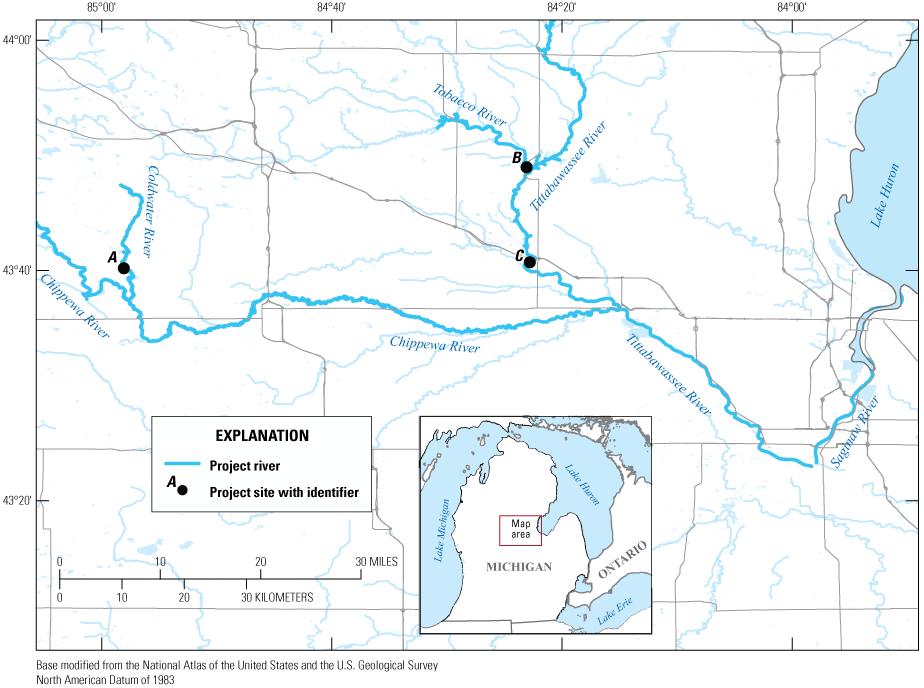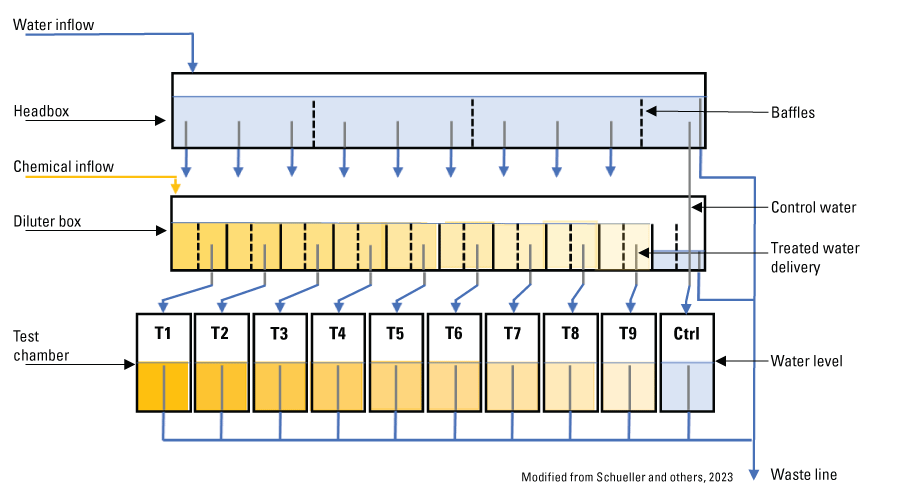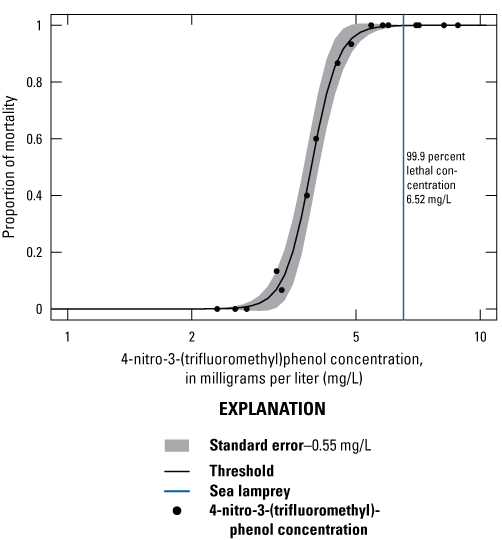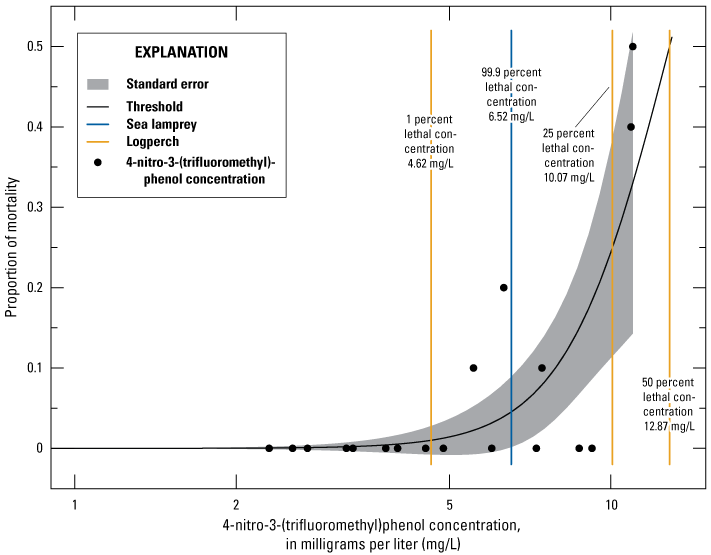Assessment of the Sensitivity of Percina caprodes (Logperch) to the Pesticide 4-Nitro-3-(trifluoromethyl)phenol
Links
- Document: Report (1.9 MB pdf) , HTML , XML
- Data Release: USGS data release - Data and code release—Technical assistance bioassay to compare sea lamprey and logperch sensitivity to TFM
- NGMDB Index Page: National Geologic Map Database Index Page (html)
- Download citation as: RIS | Dublin Core
Acknowledgments
Financial support for this study was provided from the Great Lakes Fishery Commission under a technical assistant agreement with the U.S. Geological Survey Upper Midwest Environmental Sciences Center in La Crosse, Wisconsin. We thank staff from the U.S. Fish and Wildlife Service Marquette Biological Station and the U.S. Geological Survey Hammond Bay Biological Station for participation in various stages of planning, setup, and completion of this project.
Abstract
A continuous-flow streamside toxicity test was completed to evaluate the risk posed by the use of 4-nitro-3-(trifluoromethyl)phenol (TFM), used to control Petromyzon marinus (sea lamprey), to Percina caprodes (logperch). Logperch are a host fish to the parasitic glochidia life stage of the federally endangered Epioblasma triquetra (snuffbox mussel). Streams with an extant population of snuffbox must be treated before May 1, 2023, to prevent inadvertent take through TFM-related mortality of glochidia-infested fish. Although the concentration of TFM required to induce 99.9 percent mortality of sea lamprey was 6.52 milligrams per liter, the TFM required to induce 25 percent mortality of logperch was 10.14 milligrams per liter. Our data indicate that logperch are not as sensitive to TFM as previously suggested.
Introduction
The infestation of the parasitic Petromyzon marinus (sea lamprey) has been an ongoing threat to the $7 billion industry of the Great Lakes fisheries for decades (Brant, 2019). The Great Lakes Fishery Commission’s sea lamprey control program is a binational effort to control the Great Lakes populations of parasitic sea lamprey. Nonchemical methods of control, like barriers and traps, are used to block and remove migrating adult sea lamprey, but pesticidal treatments of larval nursery streams remains the primary tool used to control sea lamprey populations (Great Lakes Fishery Commission, 2020).
The most common pesticide used to control invasive lamprey is 4-nitro-3-(trifluoromethyl)phenol (TFM, also referred to as 3-trifluoromethyl-4-nitrophenol). TFM is selectively toxic to sea lamprey, but nontarget species are known or are suspected to be sensitive at typical treatment concentrations (Boogaard and others, 2003). The sea lamprey control program was restricted annually from treating some streams with TFM after May 1 because of the potential, indirect harm to federally endangered Epioblasma triquetra (snuffbox mussel) caused when glochidia is encysted on Percina caprodes (logperch) gills (Schwalb and others, 2011).
Toxicity ratios are used to compare TFM sensitivity in nontarget fish species. These ratios are calculated by dividing the observed lethal concentration to 50 percent of the test animals (LC50) by the observed or expected lethal concentration to 99.9 percent (LC99.9) of sea lamprey (Boogaard and others, 2003). Boogaard and others (2003) suggested that a toxicity ratio of less than or equal to 1.5 indicates a species would be highly sensitive and could be severely affected. Boogaard and others (2015) found that common logperch, the primary host of the snuffbox mussel, had an LC50 of 2.5 milligrams per liter (mg/L) whereas, the sea lamprey LC99.9 was 2.1 mg/L. The resulting toxicity ratio in their study was 1.19, suggesting that logperch are highly sensitive to TFM, but handling stress and reduced conditions related to their collection, transportation, and holding prior to laboratory testing may have influenced these results.
The Tobacco River is a tributary to the Tittabawassee River that flows to the Saginaw River and finally into Lake Huron. The Tobacco and Tittabawassee rivers are in Gladwin and Midland counties, Michigan and were protected from sea lamprey by the Edenville (site B, fig. 1) and Sanford (site C, fig. 1) hydroelectric dams until they failed on May 19, 2020, after a historic flood (France and others, 2021). Until the dam is restored, the Tobacco River and its snuffbox mussels and logperch are threatened by sea lamprey (Woolnough and others, 2022; LaValley, 2022). During 2023, there was a total estimated 9,204 larval sea lamprey in the Tittabawassee River system above the failed Sanford Dam. The estimated 8,500 larval sea lampreys were specifically from the Tobacco River between the Beaverton Hydroelectric Dam and the mouth of the river (Lauren Freitas, U.S. Fish and Wildlife Service Treatment Supervisor, Ludington Biological Station, oral commun., 2024).
The goal of our study was to provide robust data to ascertain the expected sensitivity of logperch to TFM during sea lamprey control stream treatments. The specific objectives were to determine and compare the TFM sensitivities of logperch and larval sea lamprey using a replicated streamside bioassay that mimics stream treatment and minimizes handling stress of test animals.
Methods
A replicated, continuous-flow streamside bioassay was conducted on the Coldwater River (Isabella County, Michigan, 43.6699054 °N, 84.9678507° W; site A, fig. 1) with larval sea lamprey and logperch. The interconnected Coldwater River was used because it has a resident logperch population, but snuffbox mussels were not present; therefore, the potential for inadvertent take was reduced, and the river served as a model for the Tobacco River.

The Percina caprodes (logperch) and larval Petromyzon marinus (sea lamprey) bioassay sites: Coldwater River (project site A), the Edenville Dam at the confluence of the Tobacco and Tittabawassee rivers (project site B), and the Sandford Dam (project site C).
Test Animals
The animal handling and testing procedures were reviewed and approved by the U.S. Geological Survey’s Upper Midwest Environmental Sciences Center’s Institutional Animal Care and Use Committee. Test animal collections were completed by partners under Michigan scientific collector permit numbers FSCP01172023144824 and FSCP11012022100123. Larval sea lamprey (n=300) and logperch (n=200) test animals were collected using backpack electrofishing units (ABP–2, ETS Electrofishing Systems, LLC, Madison, Wisconsin) and held in wire mesh cages in the Coldwater River for 2–5 days prior to testing and distributed to the test chambers approximately 18 hours before test initiation. Sea lamprey collection procedures followed the methods described in the Larval Assessment Sampling Protocol using the ABP–2 Backpack Electrofisher in Great Lakes Streams (The Larval Assessment Task Force of the Sea Lamprey Control Program, 2019). Logperch were collected with the ABP–2 Backpack Electrofisher set at 250 volts, 60 pulses per second, and a 10 percent duty cycle. All sea lamprey were collected from the Coldwater River (Isabella County, Michigan), whereas logperch were collected from the Coldwater and Chippewa rivers (Isabella County, Michigan).
Bioassay
A replicated continuous-flow 12-hour streamside bioassay test was conducted following the methods described in the “Guide for Conducting Acute Toxicity Tests on Test Materials with Fishes, Macroinvertebrates, and Amphibians” (ASTM International, 2014) and the “Standard Operating Procedures for Application of Lampricides in the Great Lakes Fishery Commission Integrated Management of Sea Lamprey Control Program” (Barber and Steeves, 2021). The test was performed in a portable bioassay trailer using two independent continuous-flow, serial-dilution test systems constructed in a manner similar to that described in Bills and Johnson (1992). Each test system had nine serially diluted exposure chambers and an untreated control chamber (fig. 2). Stock solutions of TFM (TFM HP Sea Lamprey Larvicide, Iofina Chemicals, Covington, Kentucky) with concentrations of 16.5 grams per liter of active ingredient were prepared and delivered to the first cell of the diluter mixing boxes. The resulting TFM concentrations were then serially diluted approximately 18 percent between each exposure chamber using fresh river water delivered from the headbox. Test chambers were 40-liter high-density polyethylene containers that were fitted with standpipes adjusted to maintain approximately 20 liters of test water.

Schematic of one continuous-flow diluter system that was used during the replicated bioassay conducted on Coldwater River, Michigan, with Percina caprodes (logperch) and larval Petromyzon marinus (sea lamprey; modified from Schueller and others, 2024).
A total of 10 logperch and 15 sea lamprey larvae were randomly stocked into each test chamber for the bioassay. The logperch and the sea lamprey were free swimming but confined to stainless steel wire mesh cages in the test chambers. Dissolved oxygen, pH, and conductivity were monitored using a multiparameter water quality meter (HQ40d, Hach Company, Loveland, Colorado), and temperature was measured using a Thermapen thermometer (Mk4, ThermoWorks, American Fork, Utah). TFM concentrations in each test chamber with surviving test animals was determined hourly by spectrophotometer as described in Barber and Steeves (2021). The pH was recorded hourly in each test chamber with surviving test animals throughout the exposure. Dissolved oxygen was recorded hourly in the control chambers, and temperature was recorded hourly in the control and the highest concentration test chamber during the 12-hour exposure. Conductivity was recorded every four hours from the control tanks. Alkalinity and water hardness were measured every four hours in grab samples collected from the control test chambers. Alkalinity was determined by titrating to an endpoint of pH 4.5 according to standard method 2320B (Baird and others, 2017). Water hardness was determined by titrating with ethylenediaminetetraacetic acid according to standard method 2340C (Baird and others, 2017). Mortality assessments and removal of dead test animals were completed hourly throughout the 12-hour exposure and again 12 hours after exposure. The lengths and mass of all test animals in control chambers were measured and recorded after completion of the final mortality assessment.
Data Analysis
Descriptive statistics were generated with R and RStudio software (version 4.3.1, R Core Team, 2021; Posit Team, 2021) for the water quality properties and the test animal morphometrics. The mean TFM concentration each species was exposed to was calculated by test chamber using the hourly concentrations measured over the time each chamber contained live test animals. Species-specific dose-response curves were generated using the drc package (Ritz and others, 2015). The drc package was used to fit a two-parameter, log-logistic model for both the sea lamprey and logperch data. The sea lamprey dose-response curve was used to estimate the TFM concentration required to induce 50 (LC50) and 99.9 percent (LC99.9) mortality in sea lamprey, and the logperch dose-response curve was used to estimate the TFM required to induce lethal concentration to 1 percent of test animals (LC01), lethal concentration to 25 percent of test animals (LC25), and lethal concentration to 50 percent (LC50) of animals. Data and analysis code for this study are available in a U.S. Geological Survey data release (Kirkeeng and others, 2024).
Results
No differences were observed between replicates for pH (p-value=0.28, α=0.05), dissolved oxygen (p-value=0.60, α=0.05), temperature (p-value=0.92, α=0.05), alkalinity (p-value=0.78, α=0.05), and hardness (p-value=1.00, α=0.05). For replicate 1, the grand mean pH was 8.39, dissolved oxygen 9.37 mg/L, and temperature 15.7 degrees Celsius (°C). For replicate 2, pH was 8.41, dissolved oxygen 9.29 mg/L, and temperature 15.6°C (table 1). Mean TFM concentrations of the test chambers were calculated using hourly concentrations from test chambers that still contained that specific species (table 2). If animals from a specific species were not present in the test chamber, the hourly concentration of TFM was not used to calculate the total mean TFM concentration. Logperch had a mean mass of 5.07 (3.13) grams and a mean length of 87 (14) millimeters. Sea lamprey larvae had a mean mass of 2.27 (1.29) grams and mean length of 112 (22) millimeters.
Table 1.
Mean (standard deviation) water quality properties measured hourly during a replicated, continuous-flow streamside bioassay conducted with Petromyzon marinus (larval sea lamprey) and Percina caprodes (logperch) on the Coldwater River, Michigan.[mg/L, milligram per liter; °C, degree Celsius]
Table 2.
Mean hourly concentration of 4-nitro-3-(trifluoromethyl)phenol during a replicated, continuous-flow streamside bioassay conducted with larval Petromyzon marinus (sea lamprey) and Percina caprodes (logperch) on the Coldwater River, Michigan.[mg/L, milligram per liter]
Dose-Response Modeling
The calculated LC99.9 value from the sea lamprey dose-response curve was 6.52 mg/L (fig. 3). In replicate 2, three mortalities of logperch are suspected from shifting lamprey containment cages in two lower concentration test chambers: chamber 4 (n=2) and chamber 5 (n=1). Although this mortality may have been caused by moving the chambers, we still included them in the data analysis as resulting from TFM exposure. The calculated LC01, LC25, and LC50 values from the logperch dose-response curve were 4.62, 10.07, and 12.87 mg/L TFM, respectively (fig. 4). The toxicity ratio (logperch LC50/sea lamprey LC99.9) for logperch in this study is 1.97.

Dose-response curve of the proportion of mortality for Petromyzon marinus (sea lamprey) against the concentration of 4-nitro-3-(trifluoromethyl)phenol for the replicated, continuous-flow streamside bioassay conducted on the Coldwater River, Michigan.

Dose-response curve of the proportion of mortality for Percina caprodes (logperch) against the concentration of 4-nitro-3-(trifluoromethyl)phenol compared to Petromyzon marinus (sea lamprey) for the replicated, continuous-flow streamside bioassay conducted on the Coldwater River, Michigan.
Summary
The magnitude of the effect to nontarget species for a 4-nitro-3-(trifluoromethyl)phenol (TFM) treatment can be determined by comparing their exposure response to that of larval Petromyzon marinus (sea lamprey). A toxicity ratio of less than or equal to1.5 indicates a species would be severely affected or highly sensitive when exposed to a concentration of TFM at 1.5 times the sea lamprey lethal concentration to 99 percent of test animals (LC99.9) for an extended period. Stream treatment concentrations are typically applied at or below 2 times the expected sea lamprey LC99.9 to account for attenuation of the chemical bank as it moves downstream. A conservative toxicity ratio to define a sensitive species would be 2, meaning the concentration would be lethal to 50 percent of a species when exposed to two times the sea lamprey TFM LC99.9 for 9 hours. The toxicity ratio of Percina caprodes (logperch) was calculated to be 1.19. In this study, while conservatively including the logperch mortalities likely caused from moving the two sea lamprey cages, the toxicity ratio was calculated to be 1.97. We conclude that logperch are vulnerable to TFM during stream treatments but are less sensitive to TFM than previously indicated. Our findings are consistent with observations during TFM stream treatments which suggest logperch are sensitive but not highly sensitive to TFM. Expected logperch mortality would be approximately 5 and 23 percent at TFM concentrations of 1 and 1.5 times the sea lamprey LC99.9, respectively, for 9 hours. Logperch mortality would increase to approximately 50 percent if the TFM concentration was maintained at 2 times the sea lamprey LC99.9 for 9 hours.
References Cited
ASTM International, 2014, Guide for conducting acute toxicity tests on test materials with fishes, macroinvertebrates, and amphibians: ASTM International, West Conshohocken, Pennsylvania, 22 p, accessed May 9, 2023, at https://compass.astm.org/document/?contentCode=ASTM%7CE0729-96R14%7Cen-US&proxycl=https%3A%2F%2Fsecure.astm.org&fromLogin=trueorg.
Barber, J., and Steeves, M., 2021, Standard operating procedures for the application of lampricides in the Great Lakes Fishery Commission integrated management of sea lamprey (Petromyzon marinus) control program: Great Lakes Fishery Commission, 47 p., accessed May 9, 2023, at https://www.glfc.org/sop2021/Introduction.pdf.
Bills, T.D., and Johnson, D.A., 1992, Effect of pH on the toxicity of TFM to sea lamprey larvae and nontarget species during a stream treatment: Great Lakes Fishery Commission, U.S. Fish and Wildlife Service, Technical Report 57, p. 7–19, accessed May 9, 2023, at https://pubs.er.usgs.gov/publication/2002436.
Boogaard, M.A., Bills, T.D., and Johnson, D.A., 2003, Acute toxicity of TFM and TFM/niclosamide mixture to selected species of fish, including lake sturgeon (Acipenser fulvescens) and mudpuppies (Necturus maculosus), in laboratory and field exposures: Journal of Great Lakes Research, v. 29, Supplement 1, p. 529–541. [Also available at https://doi.org/10.1016/S0380-1330(03)70514-0.]
Boogaard, M.A., Newton, T.J., Hubert, T.D., Kaye, C.A., and Barnhart, M.C., 2015, Evaluation of the short term 12 hour toxicity of 3-trifluoromethyl-4-nitrophenol (TFM) to multiple life stages of Venustaconcha ellipsiformis and Epioblasma triquetra and its host fish (Percina Caprodes): Environmental Toxicology and Chemistry, v. 34, no. 7, p. 1634–1641. [Also available at https://doi.org/10.1002/etc.2959.]
Brant, C.O., 2019, Great Lakes sea lamprey—The 70-year war on a biological invader: Fisheries Magazine, v. 45, no. 7, 380 p., accessed May 9, 2023, at https://doi.org/10.1002/fsh.10460.
France, J.W., Alvi, I., Williams, J.L., Miller, A., and Higinbotham, S., 2021, Independent forensic team interim report—Investigation of failures of Edenville and Sanford dams: Federal Energy Regulatory Commission, 42 p., accessed May 9, 2023, at https://damfailures.org/wp-content/uploads/2022/05/IR_IFT-Interim_Edenville.pdf.
Great Lakes Fishery Commission, 2020, Sea lamprey control in the Great Lakes: 11 p., accessed May 9, 2023, at https://www.glfc.org/pubs/factsheets/FACT%205_all.pdf.
Kirkeeng, C.A., Luoma, J.A., Schloesser, N.A., Schueller, J.R., Kaye, C., and Barbour, M.T., 2024, Data and code release—Technical assistance bioassay to compare sea lamprey and logperch sensitivity to TFM: U.S. Geological Survey data release, accessed June 17, 2024, at https://doi.org/10.5066/P14HHHKA.
The Larval Assessment Task Force of the Sea Lamprey Control Program, 2019, Larval assessment sampling protocol using the AbP-2 backpack electrofisher in Great Lakes streams: 37 p., accessed May 9, 2023, at http://www.glfc.org/sop2018/app/app%20s%20Larval%20Assessment%20Sampling%20Protocol.pdf.
LaValley, S., 2022, An assessment of federally endangered snuffbox (Epioblasma triquetra) populations in Michigan, USA: Mount Pleasant, Michigan, Central Michigan University, Master’s thesis, 82 p, accessed May 9, 2023, at https://scholarly.cmich.edu/?a=d&d=CMUGR2022-035.1.11&e=-------en-10--1--txt-txIN%7CtxAU%7CtxTI--------.
Posit Team, 2021, RStudio—Integrated development Environment for R: Posit Software website, accessed May 9, 2023, at http://www.posit.co/.
R Core Team, 2021, The R project for statistical computing: R Foundation website, accessed May 9, 2023, at https://www.R-project.org/.
Ritz, C., Baty, F., Streibig, J.C., and Gerhard, D., 2015, Dose-response analysis using R: PLoS ONE, v. 10, no. 12, 11 p., accessed May 9, 2023, at https://doi.org/10.1371/journal.pone.0146021.
Schwalb, A.N., Poos, M.S., and Ackerman, J.D., 2011, Movement of logperch—The obligate host fish for endangered snuffbox mussels—Implications for mussel dispersal: Aquatic Sciences, v. 73, no. 2, p. 223–231. [Also available at https://doi.org/10.1007/s00027-010-0171-6.]
Woolnough, D.A., Laszlo, A.M., and Zanatta, D.T., 2022, General 2022 mussel survey results of Wixom and Sanford Lakes, Michigan with focus on snuffbox (Epioblasma triquetra) data—Pull ahead report for 2022 monitoring: Report for the Four Lakes Task Force, 32 p., accessed August 22, 2024, at https://storymaps.arcgis.com/stories/cfa5f86b2b6649cb9a30673e546f7382.
Conversion Factors
Supplemental Information
Concentrations of chemical constituents in water are given in milligrams per liter (mg/L).
The predicted lethal concentration to 99.99 percent (LC99.9) of sea lamprey can be found in appendix I of Barber and Steeves (2021).
For more information about this publication, contact:
Director, USGS Upper Midwest Environmental Sciences Center
2630 Fanta Reed Road
La Crosse, WI 54603
608–781–6322
For additional information, visit: https://www.usgs.gov/centers/umesc
Publishing support provided by the
Rolla Publishing Service Center
Disclaimers
Any use of trade, firm, or product names is for descriptive purposes only and does not imply endorsement by the U.S. Government.
Although this information product, for the most part, is in the public domain, it also may contain copyrighted materials as noted in the text. Permission to reproduce copyrighted items must be secured from the copyright owner.
Suggested Citation
Kirkeeng, C.A., Luoma, J.A., Schloesser, N., Schueller, J., and Kaye, C., 2024, Assessment of the sensitivity of Percina caprodes (logperch) to the pesticide 4-nitro-3-(trifluoromethyl)phenol: U.S. Geological Survey Open-File Report 2024–1064, 7 p., https://doi.org/10.3133/ofr20241064.
ISSN: 2331-1258 (online)
Study Area
| Publication type | Report |
|---|---|
| Publication Subtype | USGS Numbered Series |
| Title | Assessment of the sensitivity of Percina caprodes (logperch) to the pesticide 4-nitro-3-(trifluoromethyl)phenol |
| Series title | Open-File Report |
| Series number | 2024-1064 |
| DOI | 10.3133/ofr20241064 |
| Publication Date | October 23, 2024 |
| Year Published | 2024 |
| Language | English |
| Publisher | U.S. Geological Survey |
| Publisher location | Reston, VA |
| Contributing office(s) | Upper Midwest Environmental Sciences Center |
| Description | Report: vi, 7 p.; Data Release |
| Country | United States |
| State | Michigan |
| Online Only (Y/N) | Y |
| Additional Online Files (Y/N) | N |


